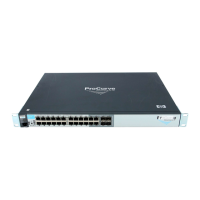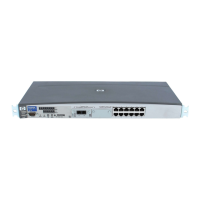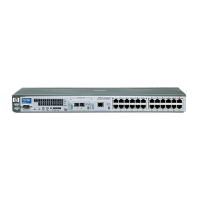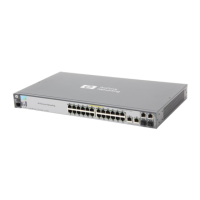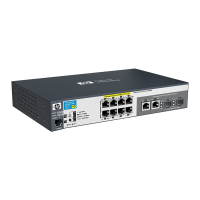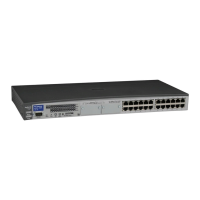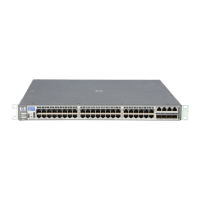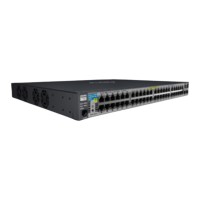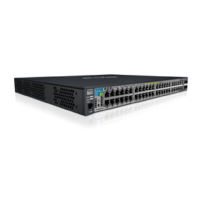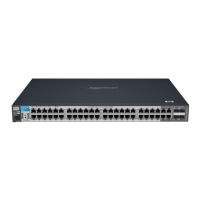

Do you have a question about the HP ProCurve 2510-24 and is the answer not in the manual?
| Model | HP ProCurve 2510-24 |
|---|---|
| Switching Capacity | 8.8 Gbps |
| Layer | Layer 2 |
| Form Factor | Rack-mountable |
| MAC Address Table Size | 8000 entries |
| Jumbo Frame Support | Yes |
| Power | AC 120/230 V (50/60 Hz) |
| Management | Web, SNMP, CLI |
| Features | VLAN support, QoS |
| Compliant Standards | IEEE 802.3, IEEE 802.3u, IEEE 802.3ab |
| Operating Temperature | 0 to 40 °C |
| Operating Humidity | 15% to 95% (non-condensing) |
| Dimensions | 44.25 x 17.3 x 4.45 cm |
Introduces the guide and its scope, detailing the supported switches and the content covered.
Explains the conventions used for command syntax and displayed information throughout the guide.
Details the syntax rules, including the use of boldface, italics, brackets, and vertical bars for commands.
Describes the different CLI prompts and how they represent privilege levels.
Offers a simplified guide for initial IP addressing setup on the switch.
Provides guidance on the physical installation and initial network setup of the switch.
Introduces the different management interfaces available for the switch.
Details the benefits and features of the menu-driven interface.
Explains the benefits and features of the Command Line Interface.
Highlights the benefits and features of the web browser interface.
Outlines the advantages of using network management software.
Explains the purpose and operation of the menu interface.
Details procedures for initiating and terminating menu interface sessions.
Lists and describes the primary features accessible from the main menu.
Explains the layout and navigation within menu interface screens.
Describes how to restart the switch using the menu interface.
Provides a comprehensive list of features available through the menu interface.
Provides an overview of the CLI and its capabilities.
Explains how to connect to and access the Command Line Interface.
Details the different privilege levels for accessing the CLI.
Explains how privilege levels affect CLI operations.
Describes the privileges and access granted to Manager users.
Explains how to view available commands and their options.
Shows how to access help information within the CLI.
Covers configuration commands and context-specific modes.
Explains keystrokes for controlling and editing CLI commands.
Introduces the web browser interface and its functionalities.
Guides on initiating a web browser session with the switch.
Outlines initial setup tasks for the web interface.
Covers setting up user accounts and passwords for security.
Explains how to access online help within the web interface.
Details how to configure URLs for support and management.
Describes features for monitoring switch status and performance.
Details how to view port utilization and status information.
Explains how to view and interpret alert log entries.
Covers configuring the policy for fault detection and alert generation.
Provides an overview of switch memory and configuration management.
Details how to make configuration changes using the Command Line Interface.
Explains how to implement configuration changes via menu and web interfaces.
Explains the use of primary and secondary flash memory for software images.
Covers procedures for downloading new switch software.
Explains various methods for rebooting the switch.
Introduces interface access and system information management.
Details methods for accessing the switch via console, web, and Telnet.
Explains how to modify interface access settings using the menu.
Covers modifying interface access configurations via the CLI.
Explains how to view and configure system parameters.
Explains how to configure system parameters using the web interface.
Introduces IP addressing configuration and its importance.
Covers the main IP addressing settings like IP address and subnet mask.
Provides a simplified procedure for basic IP address setup.
Explains how IP addressing works with multiple VLANs.
Covers configuring IP, gateway, and TTL via the menu interface.
Explains configuring IP, gateway, and TTL via the CLI.
Covers the process of automatic IP configuration using DHCP/Bootp.
Explains how to preserve IP addresses during configuration file downloads.
Introduces time synchronization protocols.
Details the SNTP protocol for time synchronization.
Guides on selecting time protocols or disabling them.
Covers managing SNTP settings via menu, CLI, and web.
Details how to manage TimeP settings via menu, CLI, and web.
Explains configuring multiple SNTP servers for unicast polling.
Introduces port status monitoring and basic configuration.
Explains how to view port status and configure parameters.
Details port status and configuration via the menu interface.
Covers port status and configuration via the CLI.
Explains port status and configuration using the web interface.
Details the QoS Pass-Through mode and its operation.
Covers setting port-based priority for incoming traffic.
Describes how to configure and use friendly names for ports.
Introduces port trunking concepts and benefits.
Covers viewing port status and configuring trunking.
Details the requirements for port trunk connections.
Explains the available options and operation of port trunking.
Outlines different methods for configuring port trunks.
Guides on configuring static trunk groups via the menu.
Covers static and dynamic trunk configuration using the CLI.
Explains how to view port trunk groups via the web interface.
Details the operation of trunk groups using LACP.
Lists important notes and restrictions for LACP.
Explains trunk group operation using the non-protocol "Trunk" option.
Explains how traffic is distributed across trunked links.
Covers managing the switch using SNMP tools.
Lists the available SNMP management features.
Details the steps for configuring SNMP access.
Explains how to configure access for SNMPv3.
Lists and describes commands for SNMPv3.
Covers configuring SNMPv3 users and their security models.
Defines the predefined group access levels for SNMP.
Explains how to configure SNMP communities for access control.
Covers managing SNMP community names via the CLI.
Details configuring SNMP traps and notifications.
Explains RMON for advanced network monitoring.
Covers the LLDP protocol for device discovery.
Covers global and per-port LLDP configuration.
Shows how to view the current LLDP configuration.
Explains global settings for LLDP packet transmission.
Details configuring advertisements for port speed and duplex.
Shows how to display LLDP advertisement data.
Explains how to display switch information for LLDP ads.
Covers viewing LLDP statistics at global and per-port levels.
Details management of LLDP and CDP data.
Explains how LLDP and CDP neighbor data is handled.
Covers the operation and commands related to CDP.
Introduces file transfer capabilities for software and configurations.
Details methods for downloading switch software.
Lists general rules for downloading switch software.
Explains downloading software via TFTP.
Details TFTP download to primary or secondary flash via CLI.
Covers secure file transfer using SCP and SFTP.
Details downloading software via Xmodem from a PC or workstation.
Guides on downloading software via Xmodem using the menu.
Covers Xmodem download to flash via CLI.
Explains transferring software between switches.
Provides steps for troubleshooting TFTP download failures.
Details copying switch configuration files.
Introduces built-in tools for monitoring and analyzing switch operation.
Explains how to access and interpret status and counter data.
Details how to view general system information.
Covers viewing management address information, including VLANs.
Explains how to view information about installed modules.
Details how to view the operational status of each port.
Covers viewing traffic patterns and flow control status.
Explains how to view MAC address tables for VLANs and ports.
Details how to view STP configuration and statistics.
Covers viewing IGMP status on a per-VLAN basis.
Explains how to display VLAN status, including ID and port status.
Describes the status overview screen in the web browser interface.
Covers features for monitoring ports and static trunks.
Explains how to use the chassislocate command to locate a switch.
Provides an overview of troubleshooting network problems.
Outlines systematic approaches to diagnosing switch problems.
Details how to detect and address chassis over-temperature conditions.
Covers troubleshooting issues with web browser and Telnet access.
Addresses problems related to abnormal network activity.
Explains how to identify and resolve duplicate IP address issues.
Addresses issues with port-based traffic prioritization.
Covers troubleshooting problems related to IGMP.
Addresses issues encountered with LACP configurations.
Troubleshoots problems with 802.1X port access control.
Covers troubleshooting issues with RADIUS authentication.
Addresses troubleshooting STP and Fast-Uplink issues.
Covers troubleshooting problems related to SSH access.
Addresses issues related to switch stacking configurations.
Covers troubleshooting problems with TACACS+ authentication.
Addresses issues with time protocols and gateway configurations.
Covers troubleshooting problems related to VLAN configurations.
Explains how to use logs to identify and diagnose problems.
Introduces various diagnostic tools available for troubleshooting.
Addresses troubleshooting issues with port auto-negotiation.
Explains how to perform ping and link tests for connectivity diagnostics.
Covers viewing switch configuration files via CLI or web.
Details methods for resetting the switch to factory defaults.
Explains how to restore a flash image, typically for OS recovery.
Introduces MAC address management functions.
Explains how to find MAC addresses assigned by the switch.
Covers viewing MAC addresses via the menu interface.
Details viewing port and VLAN MAC addresses using the CLI.
Explains how to view MAC addresses of connected network devices.
Guides on configuring Daylight Savings Time settings for the switch.
Details the user-defined option for configuring DST rules.
